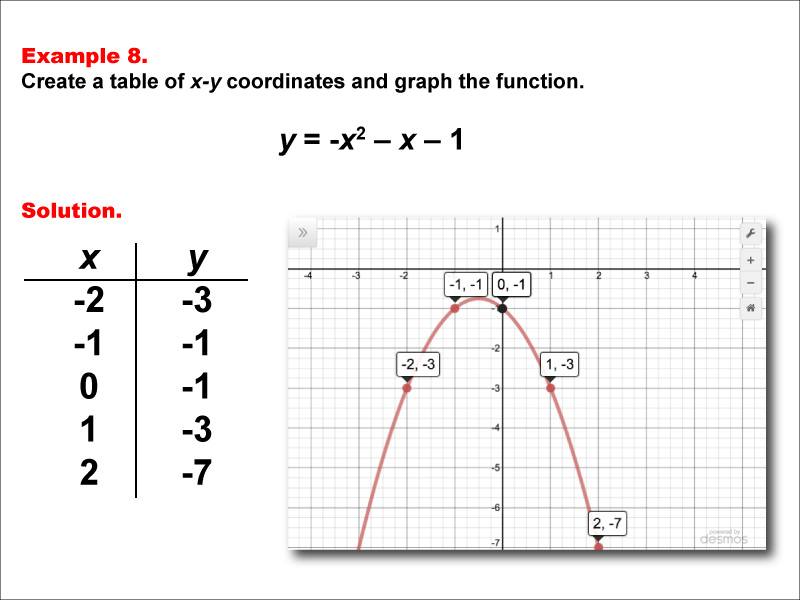

Step– by-step guide: Solving quadratic equations graphically We can calculate the solutions of a quadratic equation by plotting the graphs of the functions on both sides of the equals sign and noting where the graphs intersect. We can calculate the roots of a quadratic equation when it equals 0 by noting where the quadratic graph crosses the x axis. We can use quadratic graphs to work out estimated solutions or roots for quadratic equations or functions. Step-by-step guide: Plotting quadratic graphsĢ Solving quadratic equations graphically
#Quadratic table series#
Once we have a series of corresponding x and y values we can plot the points on a graph and join them to make a smooth curved u-shaped or n-shaped graph. We can plot quadratic graphs using a table of values and substituting values of x into a quadratic function to give the corresponding y values. Suitable conditions on the rational IFS parameters are developed so that the corresponding rational quadratic fractal interpolant inherits the positivity property of the given data.There are a variety of ways we can use quadratic graphs: The uniform convergence of the rational quadratic FIF to the original data generating function is established. The presence of the scaling factors in our rational FIF adds a layer of flexibility to its classical counterpart and provides fractality in the derivative of the interpolant.
#Quadratic table free#
(x) are preassigned quadratic polynomials involving one free shape parameter. (x) are quadratic polynomials determined through the interpolation conditions of the corresponding FIF and q For appropriate values of the IFS parameters, the resulting rational quadratic FIF converges uniformly to the original function \(\varPhi \in \mathcal \), where p

The proposed IFS schemes for the shape preserving interpolation generalize some of the classical non-recursive interpolation methods, and expand the interpolation/approximation, including approximants for which functions themselves or the first derivatives can even be non-differentiable in a dense set of points of the domain. Suitable values of the rational IFS parameters are identified so that: (i) the corresponding FIF inherits positivity and/or monotonicity properties present in the data set, and (ii) the attractor of the IFS lies within an axis-aligned rectangle. Abandoning the polynomiality of the functions defining the IFS, we introduce a new class of rational IFS that generates fractal functions (self-referential functions) for solving constrained interpolation problems. Nevertheless, the most widely studied FIFs so far in the literature that are obtained through polynomial IFSs are, in general, incapable of reproducing important shape properties inherent in a given data set.

Iterated Function Systems (IFSs) provide a standard framework for generating Fractal Interpolation Functions (FIFs) that yield smooth or non-smooth approximants. Selain itu, skim ini dibandingkan dengan bentuk konvensional splin nisbah kuadratik untuk menunjukkan kegunaan pembinaannya. Setiap skim diuji daripada banyak bentuk set data untuk menyokong kenyataan yang dibuat pembinaan berdasarkan skim tersebut. Skim lengkung interpolasi positif dan berekanada dibentangkan bagi mengekalkan ciri bentuk data masing-masing. Suatu cebisan splin nisbah kuadratik trigonometri univariat termasuk tiga parameter positif dirangka untuk menghasilkan interpolasi yang terbentuk daripada bentuk data yang diberikan. ABSTRAK Kajian ini adalah berkaitan dengan pemeliharaan bentuk interpolasi data 2D. Moreover, these schemes were compared with conventional shape preserving rational quadratic splines to demonstrate the usefulness of their construction. Each scheme was tested for plentiful shaped data sets to substantiate the assertion made in their construction. Positive and monotone curve interpolation schemes were presented to sustain the respective shape features of data. A piecewise C 1 univariate rational quadratic trigonometric spline including three positive parameters was devised to produce a shaped interpolant for given shaped data. This study was concerned with shape preserving interpolation of 2D data.


 0 kommentar(er)
0 kommentar(er)
